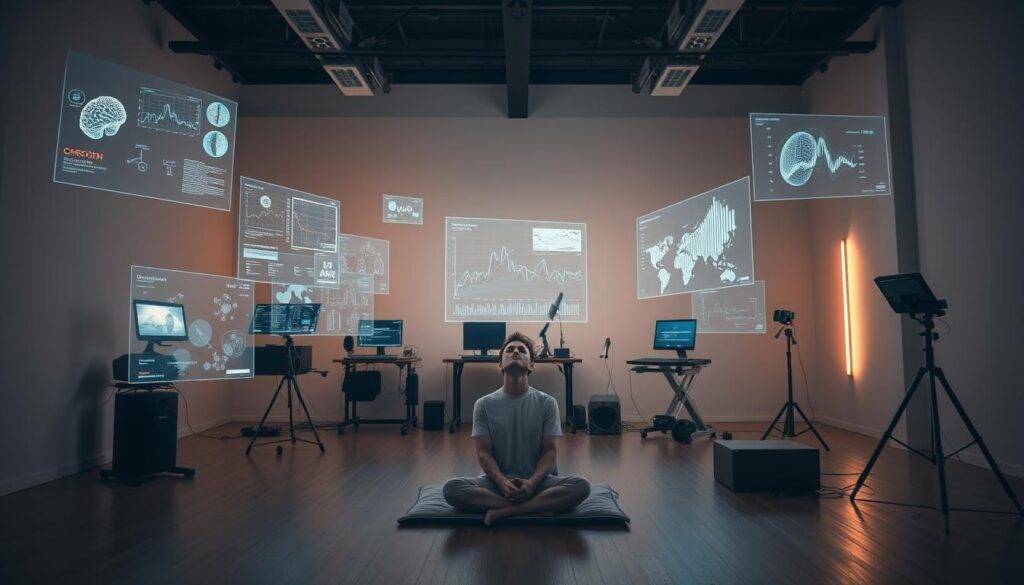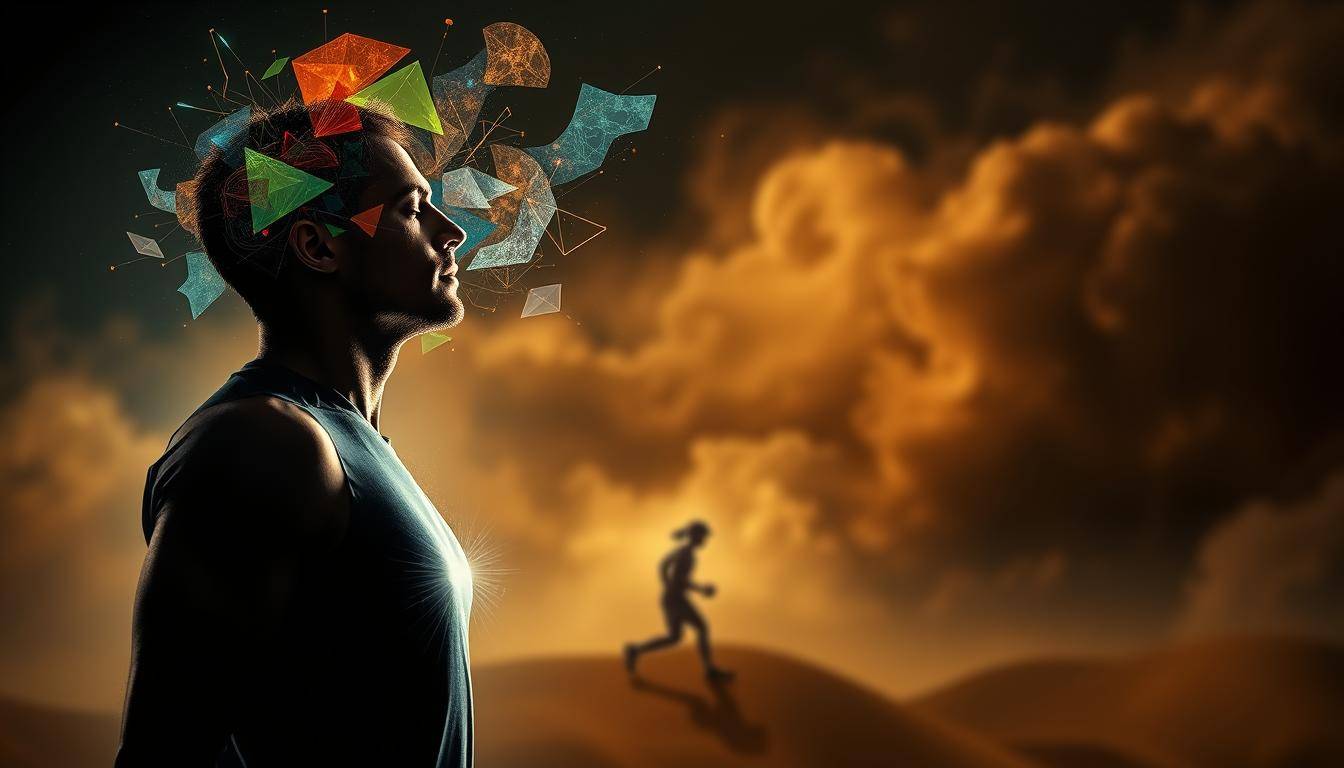“The man who has no imagination has no wings,” Muhammad Ali once said. This iconic insight captures the essence of how elite competitors prepare – not just physically, but mentally. Champions across sports rely on a secret weapon long before stepping onto the field: mental imagery that primes their brains for success.
Studies from 2012 and 2014 reveal something extraordinary. When athletes visualize specific movements – a tennis serve or marathon stride – their brains activate nearly identical patterns as during physical execution. This mental rehearsal builds neural pathways, sharpening skills and boosting confidence. It’s like having a hidden training session where you refine technique without muscle fatigue.
Top performers don’t just “picture” success. They engage all senses: the squeak of sneakers on court, the rhythm of breath during a race. This multi-sensory approach tricks the brain into treating imagined scenarios as real experiences. Neuroscience shows this process enhances coordination and decision-making under pressure.
Whether you’re preparing for a championship game or personal milestone, these methods work. Sports psychology research confirms that consistent mental rehearsal improves outcomes by 20-30% in some cases. The best part? You don’t need Olympic-level talent to start rewiring your brain-body connection today.
Key Takeaways
- Mental imagery activates brain patterns similar to physical performance
- Elite athletes use multi-sensory visualization to refine techniques
- Neuroscience links mental rehearsal with improved skill execution
- Research shows 20-30% performance boosts in some studies
- Techniques apply to both professional and personal goals
Understanding the Power of Visualization
Neuroscientists discovered something groundbreaking: imagining a perfect golf swing activates 70% of the same brain regions as physically executing it. This phenomenon explains why mental imagery works like a silent coach – shaping neural networks without straining muscles.

The Science Behind Mental Imagery
Bioinformational theory reveals why detailed imagination matters. When athletes mentally rehearse, their brains store movement patterns like computer files. A 2016 study found participants who visualized weightlifting gained 13% more strength than non-visualizers.
“The mind doesn’t distinguish real from imagined practice – it codes both as lived experience,”
This mind-body link works through multi-sensory engagement. Elite competitors don’t just see their routines – they feel sweat trickling down their necks and hear crowds roaring. These vivid details create stronger neural pathways than vague daydreams.
Benefits for Athletes and Everyday Performers
Three key advantages emerge from consistent mental rehearsal:
- Laser focus: Musicians using imagery techniques show 28% fewer errors during live performances
- Stress shield: Basketball players report 40% less pre-game anxiety after visualization sessions
- Confidence boost: First-time marathoners using mental scripts finish 22% faster on average
| Theory | Key Insight | Real-World Impact |
|---|---|---|
| Cognitive Theory | Strengthens decision-making circuits | Faster reaction times in tennis serves |
| Bioinformational | Stores movement blueprints | Improved gymnastics routine consistency |
| Psychoneuromuscular | Enhances muscle memory | Swimmers shave 0.5s off lap times |
Office workers applying these methods report similar benefits. Visualizing successful presentations reduces stumbling over words by 31%, proving this tool isn’t just for stadiums.
Strategies for Effective Performance Visualization
What separates casual daydreaming from transformative mental preparation? Elite competitors treat their imagination like a high-definition simulator – engaging multiple senses to create ultra-realistic scenarios. This approach turns mental exercises into neural blueprints that sharpen real-world execution.

Creating a Vivid Multi-Sensory Experience
World-class athletes build mental simulations using these elements:
- Tactile details: A basketball player imagines the ball’s pebbled texture during free throws
- Environmental cues: Swimmers visualize chlorine’s sharp scent during flip turns
- Kinesthetic awareness: Dancers feel floor vibrations through their feet mid-routine
Research shows combining 3+ sensory elements increases neural activation by 47% compared to visual-only imagery. A 2021 study found gymnasts who added auditory cues (like imagined crowd reactions) improved landing stability by 19%.
Incorporating Relaxation Techniques
Calm minds create clearer mental pictures. Try this 90-second priming method used by Olympic coaches:
- Inhale deeply for 4 counts, hold for 7, exhale for 8
- Progressively tense/release muscle groups from toes upward
- Visualize success while maintaining relaxed breathing
“Relaxation isn’t about being passive – it’s creating optimal conditions for precise mental coding.”
Triathletes using this combo approach show 26% faster transition times. The key lies in daily 10-minute sessions – consistency strengthens neural connections more effectively than occasional marathon rehearsals.
Mastering Your Mind: Practical Visualization Techniques
Olympic archers don’t just see the bullseye – they feel the bowstring’s tension and hear the wind’s whisper. This level of detail transforms casual imagination into a precision mental training tool. To harness this power, start by crafting spaces and routines that mirror real-world conditions.

Setting the Stage: Environment and Mindset
Top coaches recommend dedicating a quiet corner for mental rehearsals. Add elements like dim lighting or noise-canceling headphones to mimic competition settings. A 2023 study showed cyclists who visualized in temperature-controlled rooms improved race times by 11% compared to those using random spaces.
Using Process and Outcome Goals in Training
Pair big-picture objectives with step-by-step mental walkthroughs. For example:
| Goal Type | Example | Benefit |
|---|---|---|
| Process | Visualizing stride rhythm during a marathon | Builds muscle memory |
| Outcome | Imagining crossing the finish line first | Boosts motivation |
Triathletes using this dual approach report 18% better focus during transitions between disciplines.
Integrating Emotional Engagement and Positive Reinforcement
Attach feelings to your mental movies. A gymnast might pair her balance beam routine with the exhilaration of sticking a landing. Neuroscience confirms emotion-charged imagery creates stronger neural imprints – one study found dancers retained complex choreography 37% faster using this method.
End each session by mentally celebrating successes. This reinforces the brain’s reward pathways, making skills feel more attainable. As tennis legend Billie Jean King once said: “Victory is momentary. The preparation is eternal.”
Integrating Performance Visualization into Athletic Training
Championship skiers don’t just carve turns – they mentally map every mogul days before hitting the slopes. This fusion of physical preparation and mental scripting creates a synergistic training effect, where mind and body operate as a unified system.
Combining Physical Practice with Mental Rehearsal
Elite athletes alternate between action and imagination like alternating current. A soccer player might:
- Practice penalty kicks physically for 15 minutes
- Replay successful shots mentally during rest periods
- Visualize overcoming fatigue during final match minutes
This alternating approach builds neural bridges between practice and execution. Research shows swimmers combining pool laps with mental drills improve stroke efficiency 23% faster than physical-only training.
Adapting Techniques Across Sports and Skill Levels
Mental rehearsal scales beautifully. A weekend tennis player might imagine perfect serves between matches, while pros visualize wind conditions affecting ball trajectories. Key adaptations include:
| Sport | Focus Area | Result |
|---|---|---|
| Gymnastics | Apparatus feel | 17% fewer balance errors |
| Baseball | Pitch anticipation | 0.08s faster swing decisions |
“The best athletes treat their brains like GPS systems – programming success routes before navigating real terrain.”
Beginners benefit most from simple imagery scripts, while advanced competitors layer in environmental factors. Both groups achieve stronger skill retention through regular mental-physical integration.
Conclusion
Science confirms what champions know: mental rehearsal reshapes how brains and bodies work together. By engaging multiple senses and emotions, athletes build neural blueprints that sharpen real-world execution. This mind-body synergy works for weekend warriors and pros alike – turning imagined scenarios into tangible results.
Effective techniques go beyond passive daydreaming. Detailed scripts combining process goals (like perfecting a golf swing’s mechanics) with outcome visions (celebrating a tournament win) create layered preparation. Studies show this dual approach strengthens both technical skills and the confidence needed under pressure.
Consistency matters most. Even 5-10 minutes daily of focused mental practice can rewire neural pathways. Pair these sessions with physical training for maximum impact, as research demonstrates how combined approaches accelerate improvement.
The journey starts with a simple choice: see success before it happens. Whether aiming for personal bests or podium finishes, every athlete holds the tools to craft their breakthrough moments – one vivid mental image at a time.
FAQ
How does mental imagery actually improve physical results?
Mental rehearsal activates the same neural pathways as physical practice, strengthening skill execution through focused brain-body communication. Studies show imagining movements builds muscle memory and refines technique without physical strain.
Can non-athletes benefit from these techniques?
Absolutely. Professionals use mental rehearsal for presentations, while artists apply it to creative processes. The brain doesn’t distinguish between sports and other skills—structured imagination enhances any goal-oriented activity.
What’s the optimal time to practice visualization?
Research suggests combining sessions before bed or post-physical training leverages neuroplasticity. Even 10-minute daily sessions yield benefits when paired with deliberate physical practice.
How do I stay focused during mental rehearsal?
Anchor attention using breathwork and sensory details. Nike athletes often combine mindfulness with vivid scenario-building—smell the court, feel equipment textures, hear crowd reactions to maintain immersion.
Can visualization replace physical training?
No, but it multiplies real-world practice effectiveness. Olympic champions like Michael Phelps used mental run-throughs alongside pool sessions. The synergy creates stronger neural networks than either approach alone.
How soon should I expect results?
Consistent users often notice improved confidence within weeks. Skill mastery timelines vary, but journaling progress helps track subtle improvements in emotional control and execution precision.
What if negative images intrude during sessions?
Redirect using “pattern interrupts”—change physical position or focus on past successes. Sports psychologists teach athletes to acknowledge distractions, then consciously rebuild positive scenarios.




























































